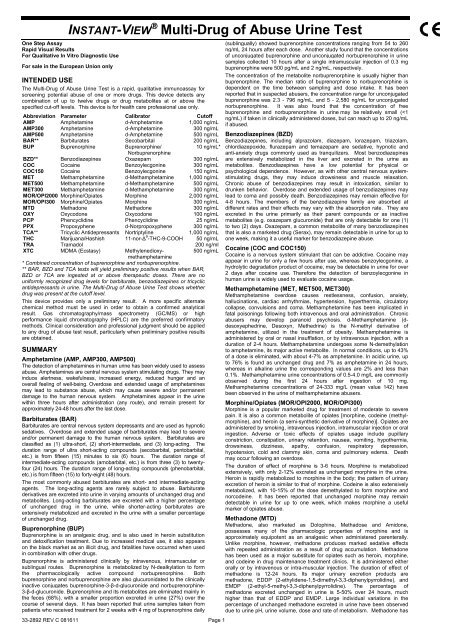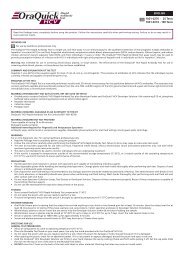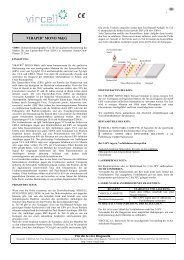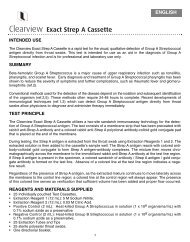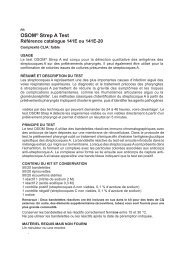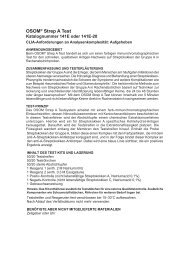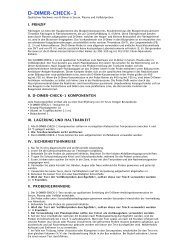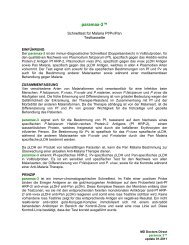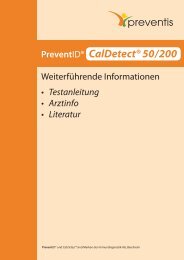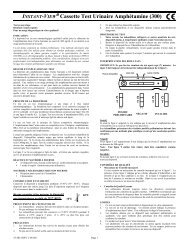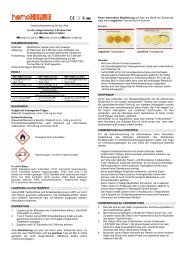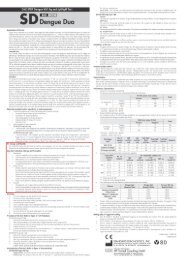INSTANT-VIEW® Multi-Drug of Abuse Urine Test - MD Doctors Direct
INSTANT-VIEW® Multi-Drug of Abuse Urine Test - MD Doctors Direct
INSTANT-VIEW® Multi-Drug of Abuse Urine Test - MD Doctors Direct
You also want an ePaper? Increase the reach of your titles
YUMPU automatically turns print PDFs into web optimized ePapers that Google loves.
<strong>INSTANT</strong>-VIEW ! <strong>Multi</strong>-<strong>Drug</strong> <strong>of</strong> <strong>Abuse</strong> <strong>Urine</strong> <strong>Test</strong><br />
One Step Assay<br />
Rapid Visual Results<br />
For Qualitative In Vitro Diagnostic Use<br />
For sale in the European Union only<br />
INTENDED USE<br />
The <strong>Multi</strong>-<strong>Drug</strong> <strong>of</strong> <strong>Abuse</strong> <strong>Urine</strong> <strong>Test</strong> is a rapid, qualitative immunoassay for<br />
screening potential abuse <strong>of</strong> one or more drugs. This device detects any<br />
combination <strong>of</strong> up to twelve drugs or drug metabolites at or above the<br />
specified cut-<strong>of</strong>f levels. This device is for health care pr<strong>of</strong>essional use only.<br />
Abbreviation Parameter Calibrator Cut<strong>of</strong>f<br />
AMP Amphetamine d-Amphetamine 1,000 ng/mL<br />
AMP300 Amphetamine d-Amphetamine 300 ng/mL<br />
AMP500 Amphetamine d-Amphetamine 500 ng/mL<br />
BAR** Barbiturates Secobarbital 200 ng/mL<br />
BUP Buprenorphine Buprenorphine/<br />
10 ng/mL*<br />
Norbuprenorphine<br />
BZD** Benzodiazepines Oxazepam 300 ng/mL<br />
COC Cocaine Benzoylecgonine 300 ng/mL<br />
COC150 Cocaine Benzoylecgonine 150 ng/mL<br />
MET Methamphetamine d-Methamphetamine 1,000 ng/mL<br />
MET500 Methamphetamine d-Methamphetamine 500 ng/mL<br />
MET300 Methamphetamine d-Methamphetamine 300 ng/mL<br />
MOR/OPI2000 Morphine/Opiates Morphine 2,000 ng/mL<br />
MOR/OPI300 Morphine/Opiates Morphine 300 ng/mL<br />
MTD Methadone Methadone 300 ng/mL<br />
OXY Oxycodone Oxycodone 100 ng/mL<br />
PCP Phencyclidine Phencyclidine 25 ng/mL<br />
PPX Propoxyphene d-Norpropoxyphene 300 ng/mL<br />
TCA** Tricyclic Antidepressants Nortriptyline 1,000 ng/mL<br />
THC Marijuana/Hashish 11-nor-! 9 -THC-9-COOH 50 ng/mL<br />
TRA Tramadol 200 ng/ml<br />
XTC <strong>MD</strong>MA (Ecstasy) Methylenedioxymethamphetamine<br />
* Combined concentration <strong>of</strong> buprenorphine and norbuprenorphine.<br />
** BAR, BZD and TCA tests will yield preliminary positive results when BAR,<br />
BZD or TCA are ingested at or above therapeutic doses. There are no<br />
uniformly recognized drug levels for barbiturate, benzodiazepines or tricyclic<br />
antidepressants in urine. The <strong>Multi</strong>-<strong>Drug</strong> <strong>of</strong> <strong>Abuse</strong> <strong>Urine</strong> <strong>Test</strong> shows whether<br />
drug was present at the cut<strong>of</strong>f level.<br />
500 ng/mL<br />
This device provides only a preliminary result. A more specific alternate<br />
chemical method must be used in order to obtain a confirmed analytical<br />
result. Gas chromatography/mass spectrometry (GC/MS) or high<br />
performance liquid chromatography (HPLC) are the preferred confirmatory<br />
methods. Clinical consideration and pr<strong>of</strong>essional judgment should be applied<br />
to any drug <strong>of</strong> abuse test result, particularly when preliminary positive results<br />
are obtained.<br />
SUMMARY<br />
Amphetamine (AMP, AMP300, AMP500)<br />
The detection <strong>of</strong> amphetamines in human urine has been widely used to assess<br />
abuse. Amphetamines are central nervous system stimulating drugs. They may<br />
induce alertness, wakefulness, increased energy, reduced hunger and an<br />
overall feeling <strong>of</strong> well-being. Overdose and extended usage <strong>of</strong> amphetamines<br />
may lead to substance abuse, which may cause severe and/or permanent<br />
damage to the human nervous system. Amphetamines appear in the urine<br />
within three hours after administration (any route), and remain present for<br />
approximately 24-48 hours after the last dose.<br />
Barbiturates (BAR)<br />
Barbiturates are central nervous system depressants and are used as hypnotic<br />
sedatives. Overdose and extended usage <strong>of</strong> barbiturates may lead to severe<br />
and/or permanent damage to the human nervous system. Barbiturates are<br />
classified as (1) ultra-short, (2) short-intermediate, and (3) long-acting. The<br />
duration range <strong>of</strong> ultra short-acting compounds (secobarbital, pentobarbital,<br />
etc.) is from fifteen (15) minutes to six (6) hours. The duration range <strong>of</strong><br />
intermediate-acting compounds (amobarbital, etc.) is from three (3) to twentyfour<br />
(24) hours. The duration range <strong>of</strong> long-acting compounds (phenobarbital,<br />
etc.) is from fifteen (15) to forty-eight (48) hours.<br />
The most commonly abused barbiturates are short- and intermediate-acting<br />
agents. The long-acting agents are rarely subject to abuse. Barbiturate<br />
derivatives are excreted into urine in varying amounts <strong>of</strong> unchanged drug and<br />
metabolites. Long-acting barbiturates are excreted with a higher percentage<br />
<strong>of</strong> unchanged drug in the urine, while shorter-acting barbiturates are<br />
extensively metabolized and excreted in the urine with a smaller percentage<br />
<strong>of</strong> unchanged drug.<br />
Buprenorphine (BUP)<br />
Buprenorphine is an analgesic drug, and is also used in heroin substitution<br />
and detoxification treatment. Due to increased medical use, it also appears<br />
on the black market as an illicit drug, and fatalities have occurred when used<br />
in combination with other drugs.<br />
Buprenorphine is administered clinically by intravenous, intramuscular or<br />
sublingual routes. Buprenorphine is metabolized by N-dealkylation to form<br />
the pharmacologically active compound norbuprenorphine. Both<br />
buprenorphine and norbuprenorphine are also glucuronidated to the clinically<br />
inactive conjugates buprenorphine-3-"-d-glucuronide and norbuprenorphine-<br />
3-"-d-glucuronide. Buprenorphine and its metabolites are eliminated mainly in<br />
the feces (68%), with a smaller proportion excreted in urine (27%) over the<br />
course <strong>of</strong> several days. It has been reported that urine samples taken from<br />
patients who received treatment for 2 weeks with 4 mg <strong>of</strong> buprenorphine daily<br />
33-2892 REV C 081611 Page 1<br />
(sublingually) showed buprenorphine concentrations ranging from 54 to 260<br />
ng/mL 24 hours after each dose. Another study found that the concentrations<br />
<strong>of</strong> unconjugated buprenorphine and unconjugated norbuprenorphine in urine<br />
samples collected 10 hours after a single intramuscular injection <strong>of</strong> 0.3 mg<br />
buprenorphine were 500 pg/mL and 2 ng/mL, respectively.<br />
The concentration <strong>of</strong> the metabolite norbuprenorphine is usually higher than<br />
buprenorphine. The median ratio <strong>of</strong> buprenorphine to norbuprenorphine is<br />
dependent on the time between sampling and dose intake. It has been<br />
reported that in suspected abusers, the concentration range for unconjugated<br />
buprenorphine was 2.3 - 796 ng/mL, and 5 - 2,580 ng/mL for unconjugated<br />
norbuprenorphine. It was also found that the concentration <strong>of</strong> free<br />
buprenorphine and norbuprenorphine in urine may be relatively small (
<strong>INSTANT</strong>-VIEW ! <strong>Multi</strong>-<strong>Drug</strong> <strong>of</strong> <strong>Abuse</strong> <strong>Urine</strong> <strong>Test</strong><br />
been found in urine at levels higher than 1,000 ng/mL 24 hours after an<br />
overdose. Therefore the concentration <strong>of</strong> methadone in human urine has<br />
been used as a marker <strong>of</strong> methadone abuse.<br />
Oxycodone (OXY)<br />
Oxycodone is a semi-synthetic opioid with a structure similar to codeine. It is<br />
prescribed for the relief <strong>of</strong> moderate to severe pain. Like all opiate agonists,<br />
oxycodone provides pain relief by acting on opioid receptors in the spinal<br />
cord, brain, and possibly directly in the affected tissues. Oxycodone is a<br />
central nervous system depressant that may cause drowsiness, dizziness,<br />
lethargy, weakness and confusion. Toxicity in an overdose <strong>of</strong> oxycodone can<br />
lead to stupor, coma, muscle flaccidity, severe respiratory depression,<br />
hypotension and respiratory arrest.<br />
Oxycodone is metabolized by demethylation into oxymorphone and<br />
noroxycodone. After a single 5 mg oral dose, 13-19% <strong>of</strong> oxycodone is<br />
excreted unchanged in a 24-hour urine collection. The time window for<br />
detection <strong>of</strong> oxycodone in urine is expected to be similar to that <strong>of</strong> other<br />
opioids such as morphine.<br />
Phencyclidine (PCP)<br />
Phencyclidine (PCP), also called Angel Dust, Hog and Killer Weed, is a<br />
popular drug <strong>of</strong> abuse, as well as a legitimate veterinary tranquilizer. It is<br />
self-administered by smoking, nasal insufflation, intravenous injection or oral<br />
ingestion. Its duration <strong>of</strong> effect is 2-4 hours, and psychosis may last for<br />
weeks. PCP has three major metabolites; however, the percentage excreted<br />
unchanged in urine after an intravenous dose is 30-50% over 72 hours. Only<br />
2% is excreted in feces. On average, 77% <strong>of</strong> an intravenous dose is<br />
excreted in urine and feces over 10 days. Therefore, PCP in human urine<br />
has been used as a marker for PCP abuse. Concentrations <strong>of</strong> unchanged<br />
drug in the urine <strong>of</strong> ambulatory PCP users are usually between 0.04 and 3.4<br />
mg/L.<br />
Propoxyphene (PPX)<br />
Propoxyphene is a prescription drug for the relief <strong>of</strong> pain. Propoxyphene<br />
hydrochloride (Darvon, Dolene) is available in 32 mg and 65 mg capsules;<br />
propoxyphene napsylate (Darvon-N) is available in 100 mg tablets or as a<br />
suspension. Propoxyphene is structurally related to methadone. As with many<br />
opioids, overdose can affect the brain region and cause euphoria. The<br />
progressive symptomatology <strong>of</strong> propoxyphene includes analgesia, stupor,<br />
respiratory depression and coma. The half-life <strong>of</strong> propoxyphene is 8-24 hours.<br />
Following oral administration, propoxyphene reaches its peak in 1 to 2 hours.<br />
There is great variability between subjects in the rate <strong>of</strong> clearance. The<br />
percentage <strong>of</strong> excreted unchanged propoxyphene in urine is less than 1%. The<br />
major metabolite <strong>of</strong> propoxyphene is norpropoxyphene. Therefore, the detection<br />
<strong>of</strong> norpropoxyphene is widely used for the testing <strong>of</strong> propoxyphene abuse. The<br />
half-life <strong>of</strong> norpropoxyphene is about 30 hours, and its accumulation with<br />
repeated doses may be responsible for some <strong>of</strong> the toxicity observed.<br />
Tricyclic Antidepressants (TCA)<br />
Tricyclic antidepressants (TCA) are antidepressant drugs that contain three<br />
fused rings in their chemical structure. TCA can be taken orally or<br />
intramuscularly. The progressive symptomatology <strong>of</strong> TCA includes agitation,<br />
confusion, hallucinations, hypertonicity, seizures and EKG changes. The<br />
half-life <strong>of</strong> TCA varies from a few hours to a few days. Commonly used<br />
tricyclic antidepressants are excreted with a very low percentage <strong>of</strong><br />
unchanged drug in the urine, less than 1%. Therefore, the detection <strong>of</strong> TCA<br />
or its metabolites in human urine has been used to screen for abuse <strong>of</strong> TCA.<br />
Marijuana (THC)<br />
Tetrahydrocannabinols (THC, " 9 -THC, " 1 -THC) are the most active principal<br />
constituents and the major metabolites <strong>of</strong> cannabinoids such as marijuana and<br />
hashish. Cannabinoids have been used as central nervous system depressants.<br />
Overdose and extended usage <strong>of</strong> cannabinoids may lead to substance abuse,<br />
which may cause severe and/or permanent damage to the human nervous<br />
system. The detection <strong>of</strong> THC in human urine is widely used to evaluate the<br />
abuse <strong>of</strong> cannabinoids.<br />
Tramadol (TRA)<br />
Tramadol is a quasi-narcotic analgesic used in the treatment <strong>of</strong> moderate to<br />
severe pain. It is a synthetic analog <strong>of</strong> codeine, but has a low binding affinity to<br />
the mu-opioid receptors. Large doses <strong>of</strong> tramadol can develop tolerance and<br />
physiological dependency and lead to its abuse. Tramadol is extensively<br />
metabolized after oral administration. Approximately 30% <strong>of</strong> the dose is<br />
excreted in the urine as unchanged drug, whereas 60% is excreted as<br />
metabolites. The major pathways appear to be N- and O- demethylation,<br />
glucoronidation or sulfation in the liver.<br />
<strong>MD</strong>MA (XTC)<br />
<strong>MD</strong>MA is an abbreviation <strong>of</strong> the chemical methylenedioxymethamphetamine. It<br />
is also known by street names such as Ecstasy, X, XTC, E, Love Doves, Clarity,<br />
Adam, Disco Biscuits and Shamrocks. <strong>MD</strong>MA is a stimulant with hallucinogenic<br />
tendencies. It is described as an empathogen since it releases mood-altering<br />
chemicals such as L-dopa in the brain and may generate feelings <strong>of</strong> love and<br />
friendliness. <strong>MD</strong>MA is a class A drug, in the same category as heroin and<br />
cocaine. The adverse effects <strong>of</strong> <strong>MD</strong>MA use include elevated blood pressure,<br />
hyperthermia, anxiety, paranoia and insomnia. Overdoses <strong>of</strong> <strong>MD</strong>MA can be<br />
fatal, <strong>of</strong>ten resulting in heart failure or heat stroke.<br />
<strong>MD</strong>MA belongs to a family <strong>of</strong> manmade drugs; its relatives are <strong>MD</strong>A<br />
(methylenedioxyamphetamine), the parent drug <strong>of</strong> <strong>MD</strong>MA, and <strong>MD</strong>EA<br />
(methylenedioxyethylamphetamine), also known as EVE. Both exhibit<br />
amphetamine-like effects. <strong>MD</strong>MA is administered either by oral ingestion or<br />
intravenous injection. <strong>MD</strong>MA tablets come in different sizes and colors, and<br />
<strong>of</strong>ten have logos such as doves on them. The clinical dose is 50-100 mg; the<br />
threshold toxic dose is 500 mg. The effects <strong>of</strong> <strong>MD</strong>MA begin 30 minutes after<br />
use. They peak in an hour and last for 2-3 hours. Sixty five percent (65%) <strong>of</strong><br />
<strong>MD</strong>MA is excreted unchanged in urine, and <strong>MD</strong>MA is detectable in urine for<br />
33-2892 REV C 081611 Page 2<br />
up to 3 days after use.<br />
PRINCIPLE OF THE PROCEDURE<br />
The <strong>Multi</strong>-<strong>Drug</strong> <strong>of</strong> <strong>Abuse</strong> <strong>Urine</strong> <strong>Test</strong> consists <strong>of</strong> any combination <strong>of</strong> between<br />
one (1) to twelve (12) individual test strip(s) for the drug(s) being tested. The<br />
assay is a one-step lateral flow chromatographic immunoassay based on the<br />
principle <strong>of</strong> competition for limited antibody binding sites between a drug or<br />
drug metabolite(s) in the sample and a drug-protein conjugate immobilized on<br />
a porous membrane support.<br />
During testing, urine migrates to the test area <strong>of</strong> the membrane by capillary<br />
action, mobilizing the colored antibody conjugates. The antibody conjugates<br />
then move along the membrane to the test area. In the absence <strong>of</strong> drug or if<br />
the drug concentration is below the cut<strong>of</strong>f limit in the sample, the colored<br />
conjugates attach to the respective drug antigen immobilized in the test line<br />
region, forming a colored band (T line). If drug is present in the sample, the<br />
drug or drug metabolite(s) compete for the limited antibody binding sites. If<br />
the drug concentration is at or above the cut<strong>of</strong>f limit, the drug will saturate all<br />
the binding sites <strong>of</strong> the antibody, preventing the attachment <strong>of</strong> the colored<br />
conjugates to the antigen in the test line area <strong>of</strong> the membrane. Therefore no<br />
colored line will form.<br />
The control line (C line) serves as an internal quality control <strong>of</strong> the system. It<br />
should always appear as a colored band regardless <strong>of</strong> the presence <strong>of</strong> the<br />
drug.<br />
REAGENTS AND MATERIALS SUPPLIED<br />
• 25 test devices, each sealed in a foil pouch with a desiccant and a dropper<br />
pipette (20 devices for 7-12 test panel)<br />
• 1 package insert (instructions for use)<br />
MATERIALS REQUIRED BUT NOT PROVIDED<br />
• Specimen collection container<br />
• Timer<br />
• External positive and negative controls<br />
PRECAUTIONS<br />
• The instructions must be followed exactly to obtain accurate results.<br />
• Do not open the sealed pouch until ready to conduct the assay.<br />
• Do not use expired devices.<br />
• Dispose <strong>of</strong> all specimens and used assay materials as potentially<br />
biohazardous.<br />
• Do not use the device if you are colorblind.<br />
STORAGE AND STABILITY<br />
• Store the product at room temperature 15-30°C (59-86°F). Each device<br />
may be used until the expiration date printed on the label if it remains<br />
sealed in its foil pouch.<br />
• Do not freeze and/or expose this kit to temperatures over 30°C.<br />
SPECIMEN COLLECTION<br />
• Each urine specimen must be collected in a clean container. Do not<br />
combine specimens.<br />
• Specimens may be kept at 15-30°C (59-86°F) for 8 hours, at 2-8°C for up<br />
to 3 days and at -20°C or below for long term storage.<br />
ASSAY PROCEDURE<br />
Important: Refrigerated specimens and other test materials, including<br />
devices, must be equilibrated to room temperature before testing.<br />
1. Bring the pouch to room temperature before opening.<br />
2. Remove the device from the sealed pouch and label it with specimen<br />
identification.<br />
3. Remove the cap from the device and add the urine sample to the device<br />
using either the “Dip Method (I)” or the “Dropper Method (II)” as described<br />
below:<br />
I. DIP METHOD<br />
a) Dip the sample well end <strong>of</strong> the device into<br />
the specimen.<br />
b) Start the timer.<br />
c) Remove the device from the specimen<br />
after 10 seconds.<br />
d) Replace the cap back onto the device. Set<br />
the device on a clean and level surface.<br />
e) Read results between 4-7 minutes.<br />
Note: Immerse the sample well<br />
completely in the urine sample. Make<br />
sure the tips <strong>of</strong> the arrows in the<br />
device window are above the surface<br />
<strong>of</strong> the urine sample.
<strong>INSTANT</strong>-VIEW ! <strong>Multi</strong>-<strong>Drug</strong> <strong>of</strong> <strong>Abuse</strong> <strong>Urine</strong> <strong>Test</strong><br />
II. DROPPER METHOD (Recommended for small sample volumes)<br />
a) Set the device on a clean and<br />
level surface.<br />
b) Use the provided dropper to<br />
pick up the urine sample and<br />
fill the dropper to the mark.<br />
c) Transfer all <strong>of</strong> the urine<br />
sample in the dropper to the<br />
sample well <strong>of</strong> the device.<br />
Avoid trapping air bubbles in<br />
the sample well.<br />
d) For a double-sided panel (7-<br />
12 drugs), turn the device<br />
over and add a full dropper<br />
<strong>of</strong> urine (up to the mark on<br />
the dropper) to the sample<br />
well on side 2.<br />
e) Start the timer.<br />
f) Read results between 4-7 minutes.<br />
INTERPRETATION OF RESULTS<br />
Each test strip is labeled with an abbreviation for its target drug. For<br />
example, “COC” indicates a cocaine test. A complete list <strong>of</strong> abbreviations<br />
can be found in the Intended Use section on Page 1.<br />
IMPORTANT:<br />
• Read each test independently.<br />
• Do not compare the color intensity <strong>of</strong> one test to anther.<br />
• Do not compare the color intensity <strong>of</strong> the T line to the C line.<br />
• Do not interpret results after 7 minutes.<br />
Preliminary Positive:<br />
If the C line appears and there is no T line, the result is a preliminary positive<br />
for that drug. More than one test may be preliminary positive.<br />
Note: Preliminary positive results should be confirmed with a more<br />
specific method. GC/MS or HPLC are the preferred confirmatory<br />
methods.<br />
C<br />
T<br />
Negative:<br />
If both the C and T lines appear for a test, the result is negative for that drug.<br />
If both the C and T lines appear for all tests, the urine specimen is negative<br />
for all the drugs tested.<br />
C<br />
T<br />
Note: Even a very faint T line is negative.<br />
Invalid:<br />
If no C line develops within 4 minutes on any test strip, the result is invalid. In<br />
this case, do not report test results. Repeat the assay with a new device. If<br />
the result is still invalid, stop using the device and contact the manufacturer.<br />
C<br />
T<br />
1 2 3 4 5 6<br />
1 2 3 4 5 6<br />
1 2 3 4 5 6<br />
QUALITY CONTROL<br />
Built-in Control Features:<br />
Each test contains a built-in control feature, the C line. The presence <strong>of</strong> the<br />
C line indicates that an adequate sample volume was used and that the<br />
reagents migrated properly. If a C line does not form, the result is invalid.<br />
Review the procedure and repeat with a new device.<br />
External Quality Control:<br />
Users should follow local guidelines concerning the running <strong>of</strong> external quality<br />
controls. SAMHSA recommends that the concentration <strong>of</strong> drug(s) in positive<br />
and negative controls be approximately 25% above and below the cut<strong>of</strong>f<br />
concentration <strong>of</strong> the assay.<br />
LIMITATIONS<br />
1. This kit is for pr<strong>of</strong>essional in vitro diagnostic use only.<br />
2. This device provides only preliminary qualitative analytical test results. A<br />
more specific alternate method must be used to obtain a confirmed<br />
analytical result.<br />
3. This product is designed for testing human urine only.<br />
4. Adulterants such as bleach or other strong oxidizing agents may produce<br />
C<br />
T<br />
C<br />
T<br />
C<br />
T<br />
Preliminary positive for<br />
test 2 and test 3<br />
Negative for<br />
all 6 drugs tested<br />
Invalid for<br />
test 4 and test 5<br />
33-2892 REV C 081611 Page 3<br />
erroneous test results. If adulteration is suspected, collect a fresh<br />
specimen and repeat the procedure with a new device.<br />
5. Samples in which bacterial contamination is suspected should not be<br />
used. These contaminants may interfere with the test and cause false<br />
results.<br />
EXPECTED VALUES<br />
This device is capable <strong>of</strong> detecting specific drugs and/or drug metabolites in<br />
human urine at or above the cut<strong>of</strong>f concentrations in the Intended Use<br />
section on page 1.<br />
PERFORMANCE CHARACTERISTICS<br />
Accuracy<br />
A comparison study was performed at two physician’s <strong>of</strong>fice laboratories<br />
(POL) and a reference laboratory. Samples were blind labeled and tested for<br />
each analyte (drug or drug metabolite). Each sample was tested at each site<br />
with the <strong>Multi</strong>-<strong>Drug</strong> <strong>of</strong> <strong>Abuse</strong> <strong>Urine</strong> <strong>Test</strong> and the results were compared to<br />
GC/MS or HPLC/MS results. The test results are grouped into drug free,<br />
below 75% cut<strong>of</strong>f (negative), above 125% cut<strong>of</strong>f (positive), between 75%<br />
cut<strong>of</strong>f and cut<strong>of</strong>f, between cut<strong>of</strong>f and 125% cut<strong>of</strong>f according to the analyte<br />
concentrations from GC/MS for all analytes except BUP and TCA, which<br />
were tested with HPLC/MS. Overall, this test exhibited more than 90%<br />
agreement with the selected analytical method for each analyte. The test<br />
results are tabulated below.<br />
Method<br />
<strong>Multi</strong>-<strong>Drug</strong> <strong>of</strong> <strong>Abuse</strong> <strong>Urine</strong> <strong>Test</strong><br />
Cut<strong>of</strong>f<br />
<strong>Drug</strong><br />
(ng/mL)<br />
AMP 1000<br />
AMP300 300<br />
AMP500 500<br />
BAR 200<br />
BZD 300<br />
COC 300<br />
COC150 150<br />
MET 1000<br />
MET500 500<br />
MET300 300<br />
MOR//O<br />
PI<br />
300<br />
MOR/OP<br />
I 2000<br />
300<br />
2000<br />
MTD 300<br />
OXY 100<br />
PCP 25<br />
PPX 300<br />
THC 50<br />
<strong>Drug</strong>free<br />
Negative<br />
125%<br />
Cut<strong>of</strong>f<br />
Overall<br />
Positive 0 0 37 15 148<br />
Negative 176 76 23 1 0<br />
Total 176 76 60 16 148 476<br />
Agreement 100% 100% 38.3% 93.8% 100% 92%<br />
Positive 0 0 0 39 75<br />
Negative 30 45 45 6 0<br />
Total 30 45 45 45 75 240<br />
Agreement 100% 100% 100% 86.7% 100% 97.5%<br />
Positive 0 0 2 9 18<br />
Negative 30 10 10 1 0<br />
Total 30 10 12 10 18 80<br />
Agreement 100% 100% 83% 90% 100% 96%<br />
Positive 0 0 0 27 140<br />
Negative 200 12 20 1 0<br />
Total 200 12 20 28 140 400<br />
Agreement 100% 100% 100% 96.4% 100% 99.8%<br />
Positive 0 0 7 32 144<br />
Negative 168 24 25 0 0<br />
Total 168 24 32 32 144 400<br />
Agreement 100% 100% 78% 100% 100% 98.3%<br />
Positive 0 0 9 24 164<br />
Negative 188 4 11 0 0<br />
Total 188 4 20 24 164 400<br />
Agreement 100% 100% 55% 100% 100% 97.8%<br />
Positive 0 0 2 42 75<br />
Negative 30 45 43 3 0<br />
Total 30 45 45 45 75 240<br />
Agreement 100% 100% 95.6% 93.3% 100% 97.9%<br />
Positive 0 0 12 24 136<br />
Negative 200 16 12 0 0<br />
Total 200 16 24 24 136 400<br />
Agreement 100% 100% 50% 100% 100% 97%<br />
Positive 0 0 6 24 152<br />
Negative 220 36 22 16 0<br />
Total 220 36 28 40 152 476<br />
Agreement 100% 100% 78.6% 60% 100% 95.4%<br />
Positive 0 0 0 38 75<br />
Negative 30 45 45 7 0<br />
Total 30 45 45 45 75 240<br />
Agreement 100% 100% 100% 84.4% 100% 97.1%<br />
Positive 0 0 13 24 136<br />
Negative 180 12 11 0 0<br />
Total 180 12 24 24 136 376<br />
Agreement 100% 100% 45.8% 100% 100% 96.5%<br />
Positive 0 0 2 28 144<br />
Negative 132 64 30 0 0<br />
Total 132 64 32 28 144 400<br />
Agreement 100% 100% 93.8% 100% 100% 99.5%<br />
Positive 0 10 36 144<br />
Negative 192 18 0 0<br />
Total 192 28 36 144 400<br />
Agreement 100% 64.3% 100% 100% 97.5%<br />
Positive 0 0 3 40 75<br />
Negative 30 45 42 5 0<br />
Total 30 45 45 45 75 240<br />
Agreement 100% 100% 93.3% 88.9% 100% 96.7%<br />
Positive 0 8 32 160<br />
Negative 184 16 0 0<br />
Total 184 24 32 160 400<br />
Agreement 100% 66.7% 100% 100% 98%<br />
Positive 0 0 0 8 30<br />
Negative 40 10 10 2 0<br />
Total 40 10 10 10 30 100<br />
Agreement 100% 100% 100% 80% 100% 98%<br />
Positive 0 0 11 17 156<br />
Negative 160 36 13 3 0<br />
Total 160 36 24 20 156 396
Method<br />
<strong>Multi</strong>-<strong>Drug</strong> <strong>of</strong> <strong>Abuse</strong> <strong>Urine</strong> <strong>Test</strong><br />
Cut<strong>of</strong>f<br />
<strong>Drug</strong><br />
(ng/mL)<br />
XTC<br />
(<strong>MD</strong>MA)<br />
500<br />
Method<br />
<strong>Multi</strong>-<strong>Drug</strong> <strong>of</strong> <strong>Abuse</strong> <strong>Urine</strong> <strong>Test</strong><br />
Cut<strong>of</strong>f<br />
<strong>Drug</strong><br />
(ng/mL)<br />
BUP 10<br />
TCA 1000<br />
<strong>INSTANT</strong>-VIEW ! <strong>Multi</strong>-<strong>Drug</strong> <strong>of</strong> <strong>Abuse</strong> <strong>Urine</strong> <strong>Test</strong><br />
Negative<br />
125%<br />
Cut<strong>of</strong>f<br />
Overall<br />
Agreement 100% 100% 54.2% 85% 100% 96.5%<br />
Positive 0 0 2 9 10<br />
Negative 40 10 9 0 0<br />
Total 40 10 11 9 10 80<br />
Agreement 100% 100% 82% 100% 100% 97.5%<br />
Negative<br />
125%<br />
Cut<strong>of</strong>f<br />
Overall<br />
Positive 0 1 18 19<br />
Negative 49 5 2 0<br />
Total 49 6 20 19 94<br />
Agreement 100% 83.3% 90% 100% 96.8%<br />
Positive 0 0 2 8 12<br />
Negative 40 10 8 0 0<br />
Total 40 10 10 8 12 80<br />
Agreement 100% 100% 80% 100% 100% 97.5%<br />
Reproducibility<br />
The reproducibility <strong>of</strong> each test was determined by replicate assays <strong>of</strong> three<br />
different production lots with four levels <strong>of</strong> samples: <strong>Drug</strong>-free, 75% cut<strong>of</strong>f,<br />
125% cut<strong>of</strong>f and 300% cut<strong>of</strong>f. For the AMP, AMP300, AMP500, BUP, COC,<br />
COC150, MET500, MET300, MOR/OPI300, OXY, THC and XTC tests, the<br />
devices were run on three consecutive days, six replicates per day, for a total<br />
<strong>of</strong> eighteen tests for each control. For the BAR, BZD, MET, MOR/OPI2000,<br />
MTD, PCP, PPX and TCA tests, the devices were run on five consecutive<br />
days, five times per day, for a total <strong>of</strong> 25 assays for each control. The results<br />
indicate 100% precision for replicates within each lot and no appreciable<br />
inter-lot variation across three different lots <strong>of</strong> devices.<br />
<strong>Drug</strong>free<br />
<strong>Drug</strong>free<br />
Cross Reactivity<br />
The cross reactivity <strong>of</strong> the device was evaluated by spiking drug free samples<br />
with structurally related compounds. Compounds producing positive<br />
responses are listed below.<br />
<strong>Drug</strong> Compound<br />
Concentration<br />
(ng/mL)<br />
Compound<br />
Concentration<br />
(ng/mL)<br />
AMP l-Amphetamine 20,000 3,4-Methylenedioxyamphetamine<br />
3,000<br />
d-l-Amphetamine 1,000<br />
(<strong>MD</strong>A)<br />
AMP300 l-Amphetamine 20,000 3,4-Methylenedioxyamphetamine<br />
3,000<br />
d-l-Amphetamine 300<br />
(<strong>MD</strong>A)<br />
AMP500 d-Amphetamine 500 3,4-Methylenedioxyamphetamine<br />
2,000<br />
l-Amphetamine 20,000<br />
(<strong>MD</strong>A)<br />
BAR Amobarbital 250 Butalbital 200<br />
Barbital 250 Pentobarbital 250<br />
Butabarbital 300 Phenobarbital 200<br />
BUP Buprenorphine-3-"-dglucuronide<br />
750 Norbuprenorphine-3-"-<br />
d-glucuronide<br />
30,000<br />
Nalorphine 100,000<br />
BZD Alprazolam 300 Lorazepam 450<br />
Bromazepam 500 Lormetazepam 300<br />
Clobazam 1,500 Medazepam 300<br />
Clonazepam 500 Nitrazepam 250<br />
Desmethyldiazepam 300 Nordiazepam 400<br />
Diazepam 200 Prazepam 250<br />
Flurazepam 300 Triazolam 300<br />
COC Benzoylecgonine 300 Isoxsuprine 1,500<br />
COC150 Benzoylecgonine 150 Isoxsuprine 1,500<br />
MET d-Amphetamine 50,000 3,4-Methylenedioxyamphetamine<br />
50,000<br />
l-Amphetamine 10,000<br />
(<strong>MD</strong>A)<br />
MET500 d-Amphetamine 50,000 3,4-Methylenedioxyamphetamine<br />
50,000<br />
l-Amphetamine 10,000<br />
(<strong>MD</strong>A)<br />
l-Methamphetamine 25,000<br />
MET300 d-Amphetamine 50,000 3,4-Methylenedioxyamphetamine<br />
50,000<br />
l-Amphetamine 10,000<br />
(<strong>MD</strong>A)<br />
l-Methamphetamine 25,000<br />
MOR/OPI Codeine 2,000 Meperidine 30,000<br />
2000 Ethyl morphine 2,000 Morphine-6-<br />
glucuronide<br />
3,000<br />
Hydromorphone 2,500<br />
MOR/OPI Codeine 300 Meperidine 30,000<br />
300 Ethyl morphine 300 Morphine-6-<br />
glucuronide<br />
500<br />
Hydromorphone 400 Oxycodone 1,000<br />
MTD (-)-#-Acetylmethadol 1,000 (-)-#-Methadol 800<br />
(LAAM)<br />
OXY Ethyl morphine 100,000 Morphine 20,000<br />
Hydrocodone 100,000<br />
PCP Methylphenidate 25,000 Tenocyclidine 2,000<br />
Pheniramine 25,000<br />
2-Ethyl-1,5-dimethyl- 200,000 Methadone 1,350,000<br />
PPX 3,3-diphenylpyrroline<br />
(EDDP)<br />
Norpropoxyphene 300<br />
TCA Amitriptyline 1,000 Nordoxepine 1,000<br />
Clomipramine 5,000 Perphenazine 75,000<br />
Cyclobenzaprine 1,500 Promazine 15,000<br />
Desipramine 800 Protriptyline 2,000<br />
Doxepin 3,000 Trimipramine 2,000<br />
Imipramine 800<br />
THC Cannabinol 50 11-nor-! 8 -THC-9-COOH 10,000<br />
11-Hydroxy-! 9 -THC 100 ! 9 -THC 10,000<br />
XTC<br />
(<strong>MD</strong>MA) Methylenedioxyamphetamine<br />
(<strong>MD</strong>A)<br />
2,000 Methylenedioxyethylamphetamine<br />
(<strong>MD</strong>EA)<br />
1,000<br />
Substance Cross-Reactivity Concentration<br />
Tramadol 100% 200 ng/mL<br />
N-Desmethyl-tramadol 40% 500 ng/mL<br />
O-Desmethyl-tramadol 1% 20,000 ng/dL<br />
Interference<br />
To determine the interference <strong>of</strong> structurally unrelated substances, various<br />
substances were tested in both drug-free urine pools and urine pools spiked<br />
with the cut<strong>of</strong>f level <strong>of</strong> each analyte.<br />
The common substances listed in this table were found not to interfere<br />
with test results at a concentration <strong>of</strong> 100 !g/mL<br />
Acetaminophen Atropine Ethanol Phenylpropanolamine<br />
Acetylsalicylic Benzoic acid Lidocaine Ranitidine<br />
acid<br />
Amikacin Caffeine Methanol Salicylic acid<br />
Ampicillin (+)-<br />
Oxalic acid Thioridazine<br />
Chlorpheniramine<br />
Arterenol Cortisone Penicillin-G Trifluoperazine<br />
Aspirin<br />
Analyte Concentration Analyte Concentration<br />
Albumin 200 $g/mL Hemoglobin 100 $g/mL<br />
Bilirubin 100 $g/mL Uric acid 100 $g/mL<br />
Creatine<br />
100 $g/mL Vitamin C<br />
100 $g/mL<br />
Glucose<br />
200 $g/mL<br />
(l-Ascorbic acid)<br />
<strong>Drug</strong>-free and spiked urine pools were tested with the <strong>Multi</strong>-<strong>Drug</strong> <strong>of</strong> <strong>Abuse</strong> <strong>Urine</strong><br />
<strong>Test</strong> at various pH levels and specific gravities. pH ranges from pH 5 to pH 9<br />
and specific gravity ranges from 1.002 – 1.035 g/mL did not affect the expected<br />
results in the study.<br />
There is a possibility that other substances and/or factors not listed above<br />
(e.g., technical or procedural errors) may interfere with the test and cause<br />
false results.<br />
REFERENCES<br />
1. FDA, Premarket Submission and Labeling Recommendations for <strong>Drug</strong>s <strong>of</strong><br />
<strong>Abuse</strong> Screening <strong>Test</strong>s--Draft Guidance for Industry and FDA Staff OIVD/DCTD<br />
152 12/02/2003.<br />
2. <strong>Urine</strong> <strong>Test</strong>ing for <strong>Drug</strong>s <strong>of</strong> <strong>Abuse</strong>. National Institute on <strong>Drug</strong> <strong>Abuse</strong> (NIDA):<br />
Research Monograph 73;1986.<br />
3. Baselt RC, Cravey RH, editors. Disposition <strong>of</strong> Toxic <strong>Drug</strong>s and Chemicals in<br />
Man. 4 th ed. Davis (CA): Biomedical Publications;1995.<br />
4. Substance <strong>Abuse</strong> and Mental Health Services Administration, Department <strong>of</strong><br />
Health and Human Services. Mandatory Guidelines for Federal Workplace <strong>Drug</strong><br />
<strong>Test</strong>ing Programs. Fed Regist. 1988;53:11970-11980.<br />
5. Department <strong>of</strong> Health and Human Services, Mandatory Guidelines for Federal<br />
Workplace <strong>Drug</strong> <strong>Test</strong>ing Programs, Fed. Register. (69): 11970 (1988).<br />
6. Wilson J. <strong>Abuse</strong>d <strong>Drug</strong>s II: A Laboratory Pocket Guide. Washington DC: AACC<br />
Press;1994.<br />
7. Gilman AG, Rall TW, Nies AS, Taylor P, editors. Goodman and Gilman’s The<br />
Pharmacological Basis <strong>of</strong> Therapeutics. 8 th ed. New York: Pergamon<br />
Press;1990.<br />
8. Dorland’s Illustrated Medical Dictionary. 26 th Edition. Philadelphia: W.B.<br />
Saunders Company;1981.<br />
9. Peroutka SJ, editor. Ecstasy: The clinical, pharmacological and<br />
neurotoxicological effects <strong>of</strong> the drug <strong>MD</strong>MA. Boston: Kluwer Academic<br />
Publishers;1990.<br />
EC REP<br />
Temperature limitation<br />
Batch/Lot code<br />
Manufacturer<br />
Contains sufficient for < n ><br />
tests<br />
Do not reuse<br />
Caution, consult accompanying<br />
documents<br />
Alfa Scientific Designs Inc.<br />
13200 Gregg St.<br />
Poway, CA 92064 – USA<br />
Made in USA<br />
REF 2892<br />
Obelis s.a<br />
Boulevard Général Wahis 53<br />
1030 Brussels, BELGIUM<br />
Tel.: +32.2.732.59.54<br />
Fax: +32.2.732.60.03<br />
Email: mail@obelis.net<br />
Use by<br />
YYYY-MM<br />
In vitro diagnostic medical<br />
device<br />
Catalog number<br />
Consult instructions for use<br />
CE Mark<br />
33-2892 REV C 081611 Page 4


